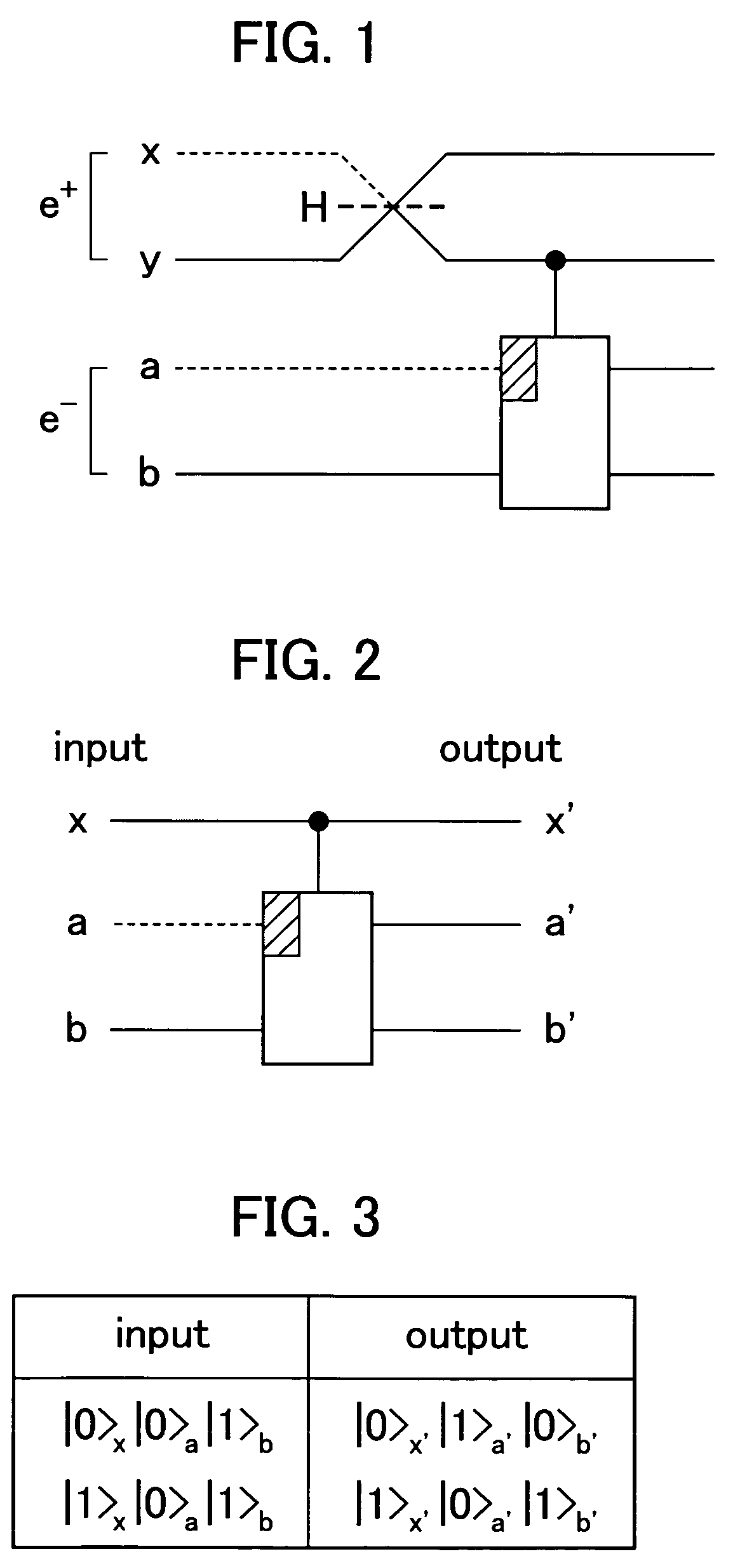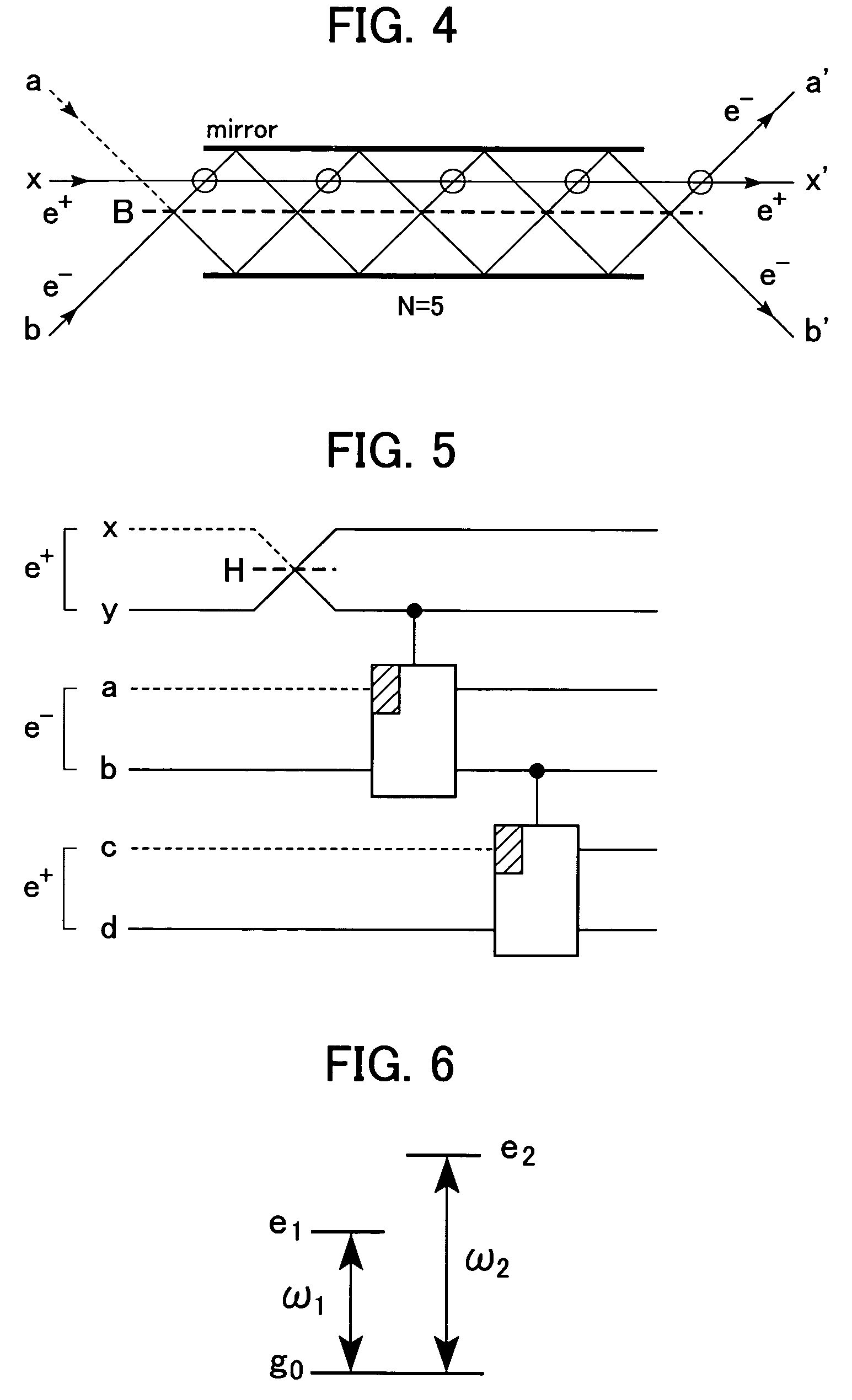Quantum-state-generating apparatus, Bell measurement apparatus, quantum gate apparatus, and method for evaluating fidelity of quantum gate
a quantum gate and generator technology, applied in the field of quantum information processing, can solve the problems of low generation efficiency of bell photon pairs (bell pairs), methods that require highly advanced experimental techniques, and cannot be put into practical use. the effect of generating a bell sta
- Summary
- Abstract
- Description
- Claims
- Application Information
AI Technical Summary
Benefits of technology
Problems solved by technology
Method used
Image
Examples
first embodiment
[0088]In a first embodiment, a Bell-state-generating apparatus will be described.
[0089]In the above-described interferometer according to Kwiat et al., the moving direction of the particle B (photon) is changed depending on the presence / absence of the particle A (absorbing object). This can be interpreted as writing information of the particle A to the particle B. Accordingly, in the present embodiment, the interferometer according to Kwiat et al. is regarded as a quantum gate between the two particles. In addition, in the interferometer according to Kwiat et al., the absorbing object is regarded as a classical particle which is either present or absent in the interferometer. In comparison, in the present embodiment, the absorbing object is regarded as a quantum particle which can be in a superposition of present and absent states in the interferometer.
[0090]In addition, in the present embodiment, the particle A is input to the quantum gate while it is in a quantum superposition of ...
second embodiment
[0109]In a second embodiment, an apparatus for generating the Bell state using a pair of photons will be described.
[0110]Generation of the Bell state using photons instead of the electron-positron pair, which causes pair annihilation, as qubits will be described below. In this case, an atom is required as an object which absorbs the photons. In the present embodiment, an experiment is considered in which only a Rabi oscillation and beam splitters for the photons are used as elements. The reason that these two elements are used is because they are frequently used in cavity-QED experiments. FIG. 6 is an energy level diagram of an auxiliary atom used for generating a two-photon Bell state by the IFM. The atom has three levels: a ground state g0, a first excited state e1, and a second excited state e2, and an energy difference between e1 and g0 and that between e2 and g0 are ω1 and ω2, respectively. It is assumed that ω2>ω1 is satisfied, ω1, ω2, and (ω2−ω1) are sufficiently large, and τ...
third embodiment
[0121]In a third embodiment, a first example of an apparatus for performing the Bell measurement will be described.
[0122]In a Bell measurement apparatus according to the present embodiment, a state to be observed is input to a quantum circuit obtained by combining the above-described quantum gate and beam splitters, and an adequate observation is performed after the state has been processed by the circuit. Then, the Bell basis of the observed state is selected from among the four Bell bases depending on the result of the observation.
[0123]A method for distinguishing two-qubit states {|Φ±>, |Ψ±>} of a system consisting of a positron and an electron from one another using the IFM gate will be described below (the Bell states obtained by a three-level atom and photons can also be distinguished from one another by a similar method). FIG. 8 shows a quantum circuit for implementing a Bell measurement using the IFM gate. One of the states {|Φ±>, |Ψ±>} is input to this quantum circuit. Alth...
PUM
 Login to View More
Login to View More Abstract
Description
Claims
Application Information
 Login to View More
Login to View More - R&D
- Intellectual Property
- Life Sciences
- Materials
- Tech Scout
- Unparalleled Data Quality
- Higher Quality Content
- 60% Fewer Hallucinations
Browse by: Latest US Patents, China's latest patents, Technical Efficacy Thesaurus, Application Domain, Technology Topic, Popular Technical Reports.
© 2025 PatSnap. All rights reserved.Legal|Privacy policy|Modern Slavery Act Transparency Statement|Sitemap|About US| Contact US: help@patsnap.com



